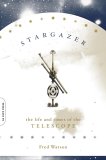Summary | Excerpt | Reviews | Beyond the Book | Readalikes | Genres & Themes | Author Bio

Critics' Opinion:
Readers' Opinion:
First Published:
Jul 2005, 360 pages
Paperback:
Jun 2006, 352 pages
 Book Reviewed by:
Book Reviewed by:
BookBrowse Review Team
Buy This Book
Power telescopes
These three things—a fixation with ground-based optical
telescopes, an obsession with size and a feverish excitement at the prospects
for adaptive optics—were the basic ingredients that fermented together in the
warm lecture theatres of Munich's International Congress Centre.
Placing them against the backdrop of the telescope's progress
over the previous hundred years, it is easy to see why they made such a potent
brew. At the turn of the twentieth century, a telescope with a mirror 1.5 metres
(60 inches) in diameter was considered large. In 1918 came a 2.5 metre (100
inch) telescope and, by 1948, a 5 metre (200 inch) was ready for work. But of
greater significance than these individual achievements was the proliferation of
4-metre class telescopes during the 1970s and early 1980s. Eight of them around
the world provided flagship tools for a new generation of astronomers. They
revolutionised our understanding of the Universe, expanding its known horizons
by billions of light-years and populating it with exotic new objects: neutron
stars, black holes and quasars.
In Munich, though, new benchmarks were being laid down.
Technology had moved on since the 1970s, and engineers had learned how to make
bigger telescopes. Then, a state-of-the-art mirror for a 4-metre class telescope
had been a thick, inert slab of glass-ceramic material that relied on sheer bulk
to maintain the profile of its reflective front surface. But now
computer-controlled mechanical fingers could hold much thinner mirrors in shape,
no matter what angle the telescope was pointing at. And the mirrors didn't have
to be made of a single piece of glass; they could be segmented from many
smaller, hexagonal pieces held in precise alignment by the same sort of
intelligent control.
With lighter mirrors came lighter telescope structures and a
spidery appearance that belied their inherent rigidity. Enclosure design became
vastly more sophisticated than the simple domes used previously, allowing air to
flow freely and smoothly past the telescope without causing local turbulence.
And improved control systems promised telescopes that could be pointed at their
targets with sub-arcsecond accuracy. With all these developments, the stage was
set for a repeat performance of the 1970s—only this time with 8-metre class
telescopes.
An 8 metre mirror is huge; it is the size of a suburban
backyard. Its reflective surface has to be of such sublime perfection that if
the mirror could be magnified to the size of the Earth, the biggest irregularity
would be no higher than a doorstep. That is one reason why the price of an
8-metre class telescope approaches US$100 million, and why multinational
consortia have to be formed to build them.
In the decade 1994–2004, no less than ten ground-based
telescopes with 8 to 10 metre mirrors would be completed. One of these
instruments actually contained two 8 metre mirrors; another incorporated four.
Three more telescopes with 6.5 metre mirrors were under construction. This was a
veritable explosion of telescope-building. And the participants in the Munich
symposium sensed, with some justification, that they were at its epicentre. The
meeting highlighted the world's burgeoning suite of 8-metre class telescopes and
the leap in light-collecting area and focusing power they presented to
astronomers: power to observe celestial objects fainter and more remote than
ever before—objects 'close to the edge of the Universe', as the tabloid
newspapers were wont to put it.
But therein lay the controversy. For if these new telescopes
were to be so effective in unlocking the secrets of the sky, what was the point
in maintaining the old ones? Shouldn't the 4-metre class telescopes be consigned
to museums in the face of the new machines? Or, at least, demoted to second-rank
instruments with minimal support—particularly those on poor observing sites . .
. ?
From Stargazer by Fred Watson, pages viii - x of the Prologue, and pages 1-17 of Chapter 1. Copyright Fred Watson. All rights reserved. Excerpt reproduced by permission of Da Capo Press.





The House on Biscayne Bay
by Chanel Cleeton
As death stalks a gothic mansion in Miami, the lives of two women intertwine as the past and present collide.

The Flower Sisters
by Michelle Collins Anderson
From the new Fannie Flagg of the Ozarks, a richly-woven story of family, forgiveness, and reinvention.

The Funeral Cryer by Wenyan Lu
Debut novelist Wenyan Lu brings us this witty yet profound story about one woman's midlife reawakening in contemporary rural China.
Your guide toexceptional books
BookBrowse seeks out and recommends the best in contemporary fiction and nonfiction—books that not only engage and entertain but also deepen our understanding of ourselves and the world around us.